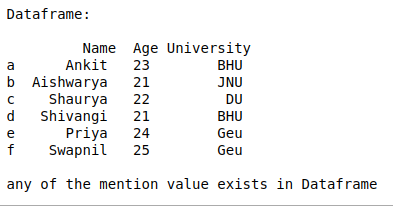En este artículo, analicemos cómo verificar si un valor dado existe en el marco de datos o no.
Método 1: use el operador in para verificar si existe un elemento en el marco de datos.
Python3
# import pandas library
import pandas as pd
# dictionary with list object in values
details = {
'Name' : ['Ankit', 'Aishwarya', 'Shaurya',
'Shivangi', 'Priya', 'Swapnil'],
'Age' : [23, 21, 22, 21, 24, 25],
'University' : ['BHU', 'JNU', 'DU', 'BHU', 'Geu', 'Geu'],
}
# creating a Dataframe object
df = pd.DataFrame(details, columns = ['Name', 'Age', 'University'],
index = ['a', 'b', 'c', 'd', 'e', 'f'])
print("Dataframe: \n\n", df)
# check 'Ankit' exist in dataframe or not
if 'Ankit' in df.values :
print("\nThis value exists in Dataframe")
else :
print("\nThis value does not exists in Dataframe")
Producción :

Método 2: use el operador not in para verificar si un elemento no existe en el marco de datos.
Python3
# import pandas library
import pandas as pd
# dictionary with list object in values
details = {
'Name' : ['Ankit', 'Aishwarya', 'Shaurya', 'Shivangi', 'Priya', 'Swapnil'],
'Age' : [23, 21, 22, 21, 24, 25],
'University' : ['BHU', 'JNU', 'DU', 'BHU', 'Geu', 'Geu'],
}
# creating a Dataframe object
df = pd.DataFrame(details, columns = ['Name', 'Age', 'University'],
index = ['a', 'b', 'c', 'd', 'e', 'f'])
print("Dataframe: \n\n", df)
# check 'Ankit' exist in dataframe or not
if 'Ankita' not in df.values :
print("\nThis value not exists in Dataframe")
else :
print("\nThis value exists in Dataframe")
Producción :

Método 3: verifique si existe un solo elemento en el marco de datos usando el método isin () del marco de datos.
Python3
# import pandas library
import pandas as pd
# dictionary with list object in values
details = {
'Name' : ['Ankit', 'Aishwarya', 'Shaurya', 'Shivangi', 'Priya', 'Swapnil'],
'Age' : [23, 21, 22, 21, 24, 25],
'University' : ['BHU', 'JNU', 'DU', 'BHU', 'Geu', 'Geu'],
}
# creating a Dataframe object
df = pd.DataFrame(details, columns = ['Name', 'Age', 'University'],
index = ['a', 'b', 'c', 'd', 'e', 'f'])
print("Dataframe: \n\n", df)
# isin() methods return Boolean
# Dataframe of given Dimension
# first any() will return boolean series
# and 2nd any() will return single bool value
res = df.isin(['Ankit']).any().any()
if res :
print("\nThis value exists in Dataframe")
else :
print("\nThis value does not exists in Dataframe")
Producción :

Método 4: verifique si alguno de los valores dados existe en el marco de datos usando el método isin () del marco de datos.
Python3
# import pandas library
import pandas as pd
# dictionary with list object in values
details = {
'Name' : ['Ankit', 'Aishwarya', 'Shaurya', 'Shivangi', 'Priya', 'Swapnil'],
'Age' : [23, 21, 22, 21, 24, 25],
'University' : ['BHU', 'JNU', 'DU', 'BHU', 'Geu', 'Geu'],
}
# creating a Dataframe object
df = pd.DataFrame(details, columns = ['Name', 'Age', 'University'],
index = ['a', 'b', 'c', 'd', 'e', 'f'])
print("Dataframe: \n\n", df)
# isin() methods return Boolean Dataframe
# of given Dimension first any() will return
# boolean series and 2nd any() will return
# single boolean value
res = df.isin(['Ankit', 'good', 30]).any().any()
if res :
print("\nany of the mention value exists in Dataframe")
else :
print("\nNone of thses values exists in Dataframe")
Producción :
